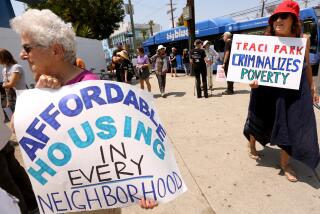Stuck on skid row
- Share via
Here’s what is passing for progress on solving Los Angeles’ homeless problem: People won’t be arrested for sleeping on the street between 9 p.m. and 6 a.m. That’s what the city agreed to do earlier this month to settle a lawsuit.
That cheerless scenario will exist until the city creates 1,250 additional units of supportive housing, at which point the city will again be free to arrest people for the crime of sleeping on sidewalks. The settlement has the germ of the right idea, however. The central antidote to homelessness is not a police sweep or a shelter bed. It’s housing.
In Los Angeles, especially on skid row -- ground zero of homelessness in our nation -- the goal of ending this disgrace may seem naive and unattainable. But across America, cities large and small have made significant progress. The numbers of homeless people on the streets of Miami, Philadelphia, New York, St. Louis, Seattle, Denver, Portland, Ore., and 20 other cities have declined in the last several years.
What have they done that Los Angeles has not? Within the context of a strategic plan, framed around business principles, they have moved homeless people with serious mental disabilities or addictions directly into housing units that include access to mental health and recovery services. As a result, these cities have stopped cycling homeless people through shelters, emergency rooms and jails -- and, overall, are seeing cost savings. It turns out that what is more humane is also more economical.
When we add up the arrests, incarcerations, emergency medical care and other crisis interventions, the true costs of chronic homelessness are staggering: $35,000 to $150,000 per person per year. By contrast, the annual cost of supportive housing for a person with serious mental illness or addiction disease is between $13,000 and $25,000. And once stabilized, many can qualify for federal disability and health insurance or get jobs that will further reduce local costs.
Yet Los Angeles seems stuck maintaining the expensive and ultimately unproductive policies of the past. On skid row, for instance, the Los Angeles Police Department deployed 50 additional officers and also expanded its drug enforcement effort. In the first year of that initiative, the LAPD issued about 12,000 citations for minor offenses and made about 9,000 arrests -- in an area with a population of about 12,000, about 5,000 of whom are homeless.
To be sure, crime is down. And preventing criminals from preying on homeless people makes sense. But arresting homeless people with mental and other disabilities just leaves them with even more problems when they are released back to the streets.
In addition, each arrest consumes the time and resources of the police, jail system, prosecutors, public defenders and courts -- to say nothing of the other expenses generated by individuals living on the street. In a recent 11-month period, there were 24 people arrested a combined 201 times in this manner. It is not unreasonable to estimate that they cost the city and county a total of $3.6 million -- money that might instead have provided supportive housing for 225 people.
The good news is that there are field-tested plans that have worked in other cities that suffered years of frustration and failure. From New York’s Times Square to San Francisco’s Tenderloin district, you can see the results: The number of people on the streets is down, and the savings in ambulance runs, emergency rooms and jails are up. In these cities, experienced teams made up of mental health and addiction clinicians, housing specialists and formerly homeless people engage those people experiencing chronic homeless, with the intent of moving them rapidly into long-term housing, not emergency shelter. The police are restored to their law enforcement role, relieved of punitive approaches and quasi-social work.
Once housed and given appropriate support and services, formerly homeless people with mental and addiction disabilities -- those for whom we used to think a bowl of soup and a blanket was the best we could do -- have a good chance of staying off the streets. In cities using this strategy, there has been an average retention rate of 85%.
There is no reason a city as entrepreneurial and creative as Los Angeles cannot join the ranks of cities seeing visible and quantifiable change on its streets. Getting there will require leadership and concerted effort from the city and county, as well as the active engagement of community stakeholders -- business leaders, police, courts, hospitals, social services providers, academics, philanthropists, homeless people, faith-based groups and others.
In successful cities, such groups came together to develop a 10-year action plan based on business principles: clear goals, incremental benchmarks and accountability for outcomes. Such plans compel cities to stop managing a crisis and start investing in solutions.
To the credit of the county supervisors and the mayor, new county resources for social services are on the table, as are city housing funds. Also, to the credit of some agencies, innovative housing strategies are present. What’s missing is that business-style 10-year plan with a clear goal that will orchestrate city, county and private initiatives.
The goal part should be simple: ending chronic homelessness in Los Angeles, starting with skid row.
Los Angeles should join this national movement. Now.
More to Read
Sign up for Essential California
The most important California stories and recommendations in your inbox every morning.
You may occasionally receive promotional content from the Los Angeles Times.






